Related Research Articles
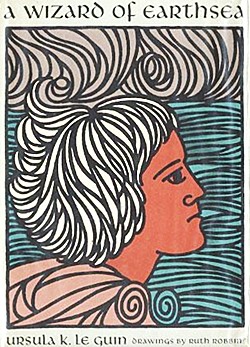
A Wizard of Earthsea is a fantasy novel written by American author Ursula K. Le Guin and first published by the small press Parnassus in 1968. It is regarded as a classic of children's literature and of fantasy, within which it is widely influential. The story is set in the fictional archipelago of Earthsea and centers on a young mage named Ged, born in a village on the island of Gont. He displays great power while still a boy and joins a school of wizardry, where his prickly nature drives him into conflict with a fellow student. During a magical duel, Ged's spell goes awry and releases a shadow creature that attacks him. The novel follows Ged's journey as he seeks to be free of the creature.

Fritz Reuter Leiber Jr. was an American writer of fantasy, horror, and science fiction. With writers such as Robert E. Howard and Michael Moorcock, Leiber is one of the fathers of sword and sorcery.

Sword and sorcery (S&S) or heroic fantasy is a subgenre of fantasy characterized by sword-wielding heroes engaged in exciting and violent adventures. Elements of romance, magic, and the supernatural are also often present. Unlike works of high fantasy, the tales, though dramatic, focus on personal battles rather than world-endangering matters. Sword and sorcery commonly overlaps with heroic fantasy. The genre originated from the early-1930s works of Robert E. Howard. The term "sword and sorcery" was coined by Fritz Leiber in the May 1961 issue of the fantasy fanzine Amra, to describe Howard and the stories that were influenced by his works. In parallel with "sword and sorcery", the term "heroic fantasy" is used, although it is a more loosely defined genre.

The Two Towers is the second volume of J. R. R. Tolkien's high fantasy novel The Lord of the Rings. It is preceded by The Fellowship of the Ring and followed by The Return of the King. The volume's title is ambiguous, as five towers are named in the narrative, and Tolkien himself gave conflicting identifications of the two towers. The narrative is interlaced, allowing Tolkien to build in suspense and surprise. The volume was largely welcomed by critics, who found it exciting and compelling, combining epic narrative with heroic romance.
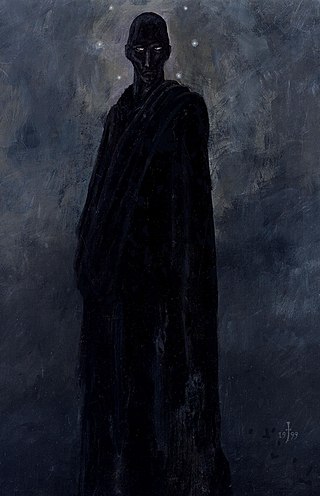
Nyarlathotep is a fictional character created by H. P. Lovecraft. The character is a malign deity in the Cthulhu Mythos, a shared universe. First appearing in Lovecraft's 1920 prose poem "Nyarlathotep", he was later mentioned in other works by Lovecraft and by other writers. Later, writers describe him as one of the Outer Gods, an alien pantheon.

Oberon is a king of the fairies in medieval and Renaissance literature. He is best known as a character in William Shakespeare's play A Midsummer Night's Dream, in which he is King of the Fairies and spouse of Titania, Queen of the Fairies.
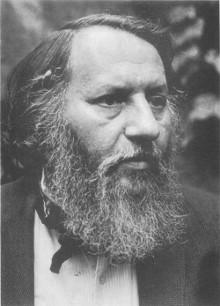
Avram Davidson was an American writer of fantasy fiction, science fiction, and crime fiction, as well as the author of many stories that do not fit into a genre niche. He won a Hugo Award and three World Fantasy Awards in the science fiction and fantasy genre, a World Fantasy Life Achievement award, and an Ellery Queen's Mystery Magazine short story award and an Edgar Award in the mystery genre. Davidson edited The Magazine of Fantasy and Science Fiction from 1962 to 1964. His last novel The Boss in the Wall: A Treatise on the House Devil was completed by Grania Davis and was a Nebula Award finalist in 1998. The Encyclopedia of Science Fiction says "he is perhaps sf's most explicitly literary author".

The Magazine of Fantasy & Science Fiction is a U.S. fantasy and science fiction magazine, first published in 1949 by Mystery House, a subsidiary of Lawrence Spivak's Mercury Press. Editors Anthony Boucher and J. Francis McComas had approached Spivak in the mid-1940s about creating a fantasy companion to Spivak's existing mystery title, Ellery Queen's Mystery Magazine. The first issue was titled The Magazine of Fantasy, but the decision was quickly made to include science fiction as well as fantasy, and the title was changed correspondingly with the second issue. F&SF was quite different in presentation from the existing science fiction magazines of the day, most of which were in pulp format: it had no interior illustrations, no letter column, and text in a single-column format, which in the opinion of science fiction historian Mike Ashley "set F&SF apart, giving it the air and authority of a superior magazine".

Unknown was an American pulp fantasy fiction magazine, published from 1939 to 1943 by Street & Smith, and edited by John W. Campbell. Unknown was a companion to Street & Smith's science fiction pulp, Astounding Science Fiction, which was also edited by Campbell at the time; many authors and illustrators contributed to both magazines. The leading fantasy magazine in the 1930s was Weird Tales, which focused on shock and horror. Campbell wanted to publish a fantasy magazine with more finesse and humor than Weird Tales, and put his plans into action when Eric Frank Russell sent him the manuscript of his novel Sinister Barrier, about aliens who own the human race. Unknown's first issue appeared in March 1939; in addition to Sinister Barrier, it included H. L. Gold's "Trouble With Water", a humorous fantasy about a New Yorker who meets a water gnome. Gold's story was the first of many in Unknown to combine commonplace reality with the fantastic.
Jack Dann is an American writer best known for his science fiction, as well as an editor and a writing teacher, who has lived in Australia since 1994. He has published over seventy books, the majority being as editor or co-editor of story anthologies in the science fiction, fantasy and horror genres. He has published nine novels, numerous shorter works of fiction, essays, and poetry, and his books have been translated into thirteen languages. His work, which includes fiction in the science fiction, fantasy, horror, magical realism, and historical and alternative history genres, has been compared to Jorge Luis Borges, Roald Dahl, Lewis Carroll, J. G. Ballard, and Philip K. Dick.

The Dream-Quest of Unknown Kadath is a novella by American writer H. P. Lovecraft. Begun probably in the autumn of 1926, the draft was completed on January 22, 1927 and it remained unrevised and unpublished in his lifetime. It is both the longest of the stories that make up his Dream Cycle and the longest Lovecraft work to feature protagonist Randolph Carter. Along with his 1927 novel The Case of Charles Dexter Ward, it can be considered one of the significant achievements of that period of Lovecraft's writing. The Dream-Quest combines elements of horror and fantasy into an epic tale that illustrates the scope and wonder of humankind's ability to dream.
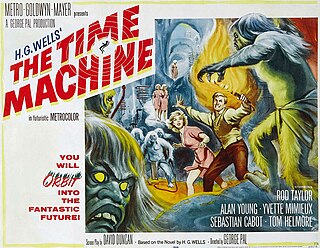
Time travel is a common theme in fiction, mainly since the late 19th century, and has been depicted in a variety of media, such as literature, television, film, and advertisements.
"The Temple" is a short story written by H. P. Lovecraft in 1920, and first published in the pulp magazine Weird Tales #24 in September 1925.
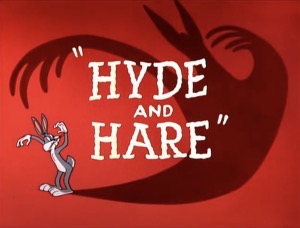
Hyde and Hare is a 1955 Warner Bros. Looney Tunes cartoon, directed by Friz Freleng. The short was released on August 27, 1955, and stars Bugs Bunny. The short is based on Robert Louis Stevenson's 1886 novella Strange Case of Dr Jekyll and Mr Hyde. The cartoon pits Bugs against Dr. Jekyll, who continues to turn into Mr. Hyde. The title is a play on the expression "neither hide nor hair."
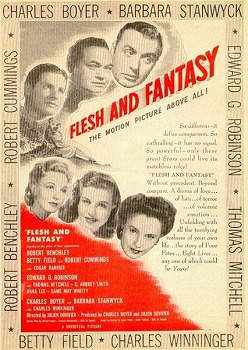
Flesh and Fantasy is a 1943 American anthology film directed by Julien Duvivier and starring Edward G. Robinson, Charles Boyer, Robert Cummings, and Barbara Stanwyck. The making of this film was inspired by the success of Duvivier's previous anthology film, the 1942 Tales of Manhattan. Flesh and Fantasy tells three stories, unrelated but with a supernatural theme, by Ellis St. Joseph, Oscar Wilde, and László Vadnay. Tying together the three segments is a conversation about the occult between two clubmen, one played by humorist Robert Benchley.

Typewriter in the Sky is a science fantasy novel by American writer L. Ron Hubbard. The protagonist Mike de Wolf finds himself inside the story of his friend Horace Hackett's book. He must survive conflict on the high seas in the Caribbean during the 17th century, before eventually returning to his native New York City. Each time a significant event occurs to the protagonist in the story he hears the sounds of a typewriter in the sky. At the story's conclusion, de Wolf wonders if he is still a character in someone else's story. The work was first published in a two-part serial format in 1940 in Unknown Fantasy Fiction. It was twice published as a combined book with Hubbard's work Fear. In 1995 Bridge Publications re-released the work along with an audio edition.

"The Guided Man" is a classic science fiction short story by L. Sprague de Camp. It was first published in the magazine Startling Stories for October, 1952. It first appeared in book form in the collection A Gun for Dinosaur and Other Imaginative Tales. It has also appeared in Science Fiction Yearbook no. 3 and the collection The Best of L. Sprague de Camp. The story has been translated into German.
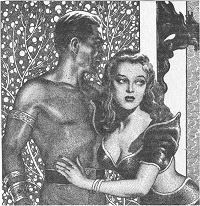
"Cornzan the Mighty" is a classic science fiction story by L. Sprague de Camp. It was first published under the variant title "Cornzan, the Mighty" in the magazine Future Science Fiction for December, 1955. All later appearances omit the comma. It first appeared in book form in the collection A Gun for Dinosaur and Other Imaginative Tales. The story has been translated into German.
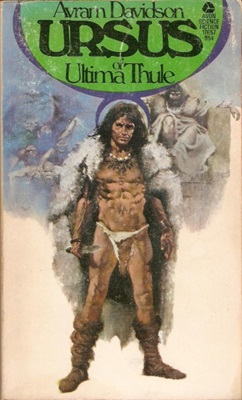
Ursus of Ultima Thule is a fix-up fantasy novel by American writer Avram Davidson. It originally appeared as the novella "Arnten of Ultima Thule" in If v. 20, no. 12, July/August 1971, and the two-part serial "The Forges of Nainland are Cold" in Fantastic, v. 21, no. 6-v. 22, no. 1, August–October 1972. The complete novel, which incorporated a new chapter as a bridge between the two component stories, was first published in paperback by Avon Books in December 1973. It was reissued in hardcover and trade paperback by Wildside Press in March 2000, with an audiobook edition following from the save publisher in November 2011. Ebook editions were issued by Prologue Books in August 2012 and SF Gateway in May 2013.
References
- ↑ Joshi, S. T.; Dziemianowicz, Stefan R. (2005). Supernatural Literature of the World: An Encyclopedia, Volume 3, P–Z. Greenwood Press. p. 1088. ISBN 978-0-313-32777-3.
- 1 2 Davidson, Avram, ed. (1983). Magic for Sale. New York: Berkley Publishing Group. p. 161. ISBN 0-441-51535-5.
- ↑ D'Ammassa, Don (2006), "Shottle Bop", Encyclopedia of Fantasy and Horror Fiction, p. 319, ISBN 978-0-8160-6192-1